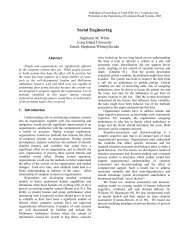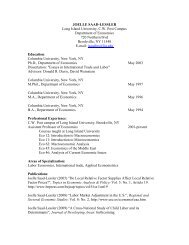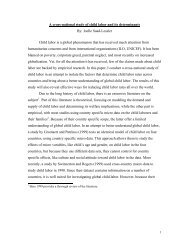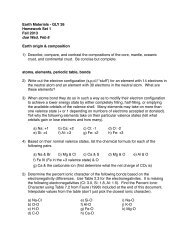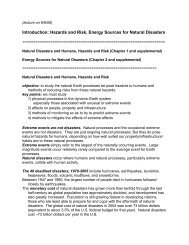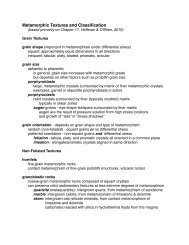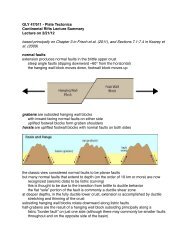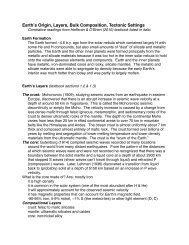Properties of Aquifers Part I - Porosity & Permeability - Myweb @ CW ...
Properties of Aquifers Part I - Porosity & Permeability - Myweb @ CW ...
Properties of Aquifers Part I - Porosity & Permeability - Myweb @ CW ...
You also want an ePaper? Increase the reach of your titles
YUMPU automatically turns print PDFs into web optimized ePapers that Google loves.
GLY 15/518 - Groundwater Geology<br />
Chapter 2: Sections 3.2 - 3.5<br />
Material for week <strong>of</strong> 9/17/12<br />
<strong>Properties</strong> <strong>of</strong> Aquifer Materials<br />
There are two basic characteristics <strong>of</strong> an aquifer in terms <strong>of</strong> its potential as a water<br />
resource.<br />
I) First is various measures as to how much water is held in an aquifer including:<br />
porosity (η), specific yield (Sy), and storage (Sr)<br />
II) The other is measures <strong>of</strong> how easily the water flows through the aquifer:<br />
permeability, hydraulic conductivity (k), transmissivity (T)<br />
I) Quantity <strong>of</strong> Available Water in an Aquifer<br />
porosity types: Most sediment and rock contains some amount <strong>of</strong> void space<br />
intergrain spaces: ! a primary porosity in sediments and sedimentary rock<br />
! ! (though cementation decreases this)<br />
vessicles: !<br />
a primary porosity in volcanic rocks<br />
dissolution voids: ! a secondary porosity in limestone<br />
fractures: !<br />
a secondary porosity in all kinds <strong>of</strong> rock<br />
porosity: Porous aquifer materials contain void spaces throughout the mass <strong>of</strong><br />
sediment and rock. The space available for water storage can be defined as<br />
porosity in sediments: The amount <strong>of</strong> void space in sediments and sedimentary rocks<br />
depends on the properties <strong>of</strong> the materials, including packing, grain size, grain<br />
shape, sorting, the degree <strong>of</strong> cementation, etc.<br />
packing: Uniform-size spheres stacked one on top <strong>of</strong> another (like balls in a box) have<br />
a cubic packing structure. Cubic packing results in about 48% porosity (52% <strong>of</strong><br />
space taken up by the solid balls). If uniform spheres are stacked so the spheres <strong>of</strong><br />
every other row fit into the hollows between balls <strong>of</strong> the adjacent row, this<br />
rhombohedral packing reduces porosity to its minimum (for uniform spheres) <strong>of</strong><br />
about 26%. Of course natural sediments are neither perfectly spherical, perfectly<br />
uniform in size, nor packed in perfectly cubic or rhombohedral order but will fall<br />
somewhere between those two end members.<br />
sorting: Well-sorted (fairly uniformly sized) sediments (or spheres) maintain a relatively<br />
high degree <strong>of</strong> porosity. But if sediments occur in a mixture <strong>of</strong> sizes, the smaller<br />
particles will fill in the spaces between the larger particles, reducing the porosity.
sediment size:<br />
geological classification:! gravel: particles > 2mm (boulders, cobbles, pebbles, granules)<br />
! sand: particles between 2 mm and 1/16 mm<br />
! silt: particles between 1/16 mm and 1/256 mm<br />
! clay: particles smaller than 1/256 mm<br />
Gravel and sand are all visible particles. Clay and all but the very coursest silt are<br />
microscopic. Silt and clay are called mud.<br />
sediment size gradation: The size distribution <strong>of</strong> a sediment is determined by passing<br />
a sample through a stack <strong>of</strong> nested baskets with each lower basket having a finer wire<br />
mesh. The size fractions caught in each basket are then weighed. The sediment size<br />
distribution is then plotted on a semi-log grain-size distribution plot. A wide distribution<br />
<strong>of</strong> particle sizes is a poorly sorted sediment. A tight distribution <strong>of</strong> grain sizes is a wellsorted<br />
sediment.<br />
uniformity coefficient, C u is a measure <strong>of</strong> the gradation <strong>of</strong> a sediment. It is<br />
calculated as the following ratio:<br />
C u = d 60 / d 10<br />
d 60 = soil particle diameter at which 60% <strong>of</strong> the mass <strong>of</strong> a soil sample is finer<br />
d 10 = the diameter at which 10% is finer<br />
d 60 and d 10 can be read <strong>of</strong>f a grain-size distribution plot<br />
C u > 6 is well graded (poorly-sorted)<br />
porosity ranges<br />
well-sorted gravel or sand! 25-50% porosity<br />
poorly-sorted gravel and sand! 20-35%<br />
silt or clay! 33-60%<br />
effective porosity<br />
However, not all <strong>of</strong> the water in pore spaces is available (can drain out). Some water is<br />
held by capillary forces (capillary water) and some by electrostatic forces<br />
(hygroscopic water). The available water is called gravitational water because it is<br />
able to drain out <strong>of</strong> the rock under the force <strong>of</strong> gravity.<br />
The effective porosity is less than the total porosity because <strong>of</strong> these forces that retain<br />
water in the pores spaces.
The term specific yield (Sy) is another term for effective porosity, but is commonly used<br />
when referring to an aquifer rather than individual samples.<br />
Specific retention (Sr) refers to the portion <strong>of</strong> the total porosity that is not available due<br />
to capillary and electrostatic forces.<br />
porosity = specific yield + specific retention<br />
η = S y + S r<br />
Fine sediments like clay and silt have a high porosity but also a high specific retention<br />
and low specific yield. Capillary and electrostatic forces become very important in fine<br />
sediments where the pores spaces are very small. Clay minerals have electrostatic<br />
forces that attract large amounts <strong>of</strong> water (dipolar molecule).<br />
Coarse sediments like sand and gravel have a lower porosity than fine sediments but<br />
high specific yield and low specific retention because the void spaces are larger and<br />
electrostatic attractions are much less. A much smaller proportion <strong>of</strong> water in voids is in<br />
close contact to the grains. Coarse and medium sand generally has the greatest<br />
specific yield because the void spaces are still relatively large, but they have greater<br />
porosity than gravel (cobbles & boulders).<br />
determination <strong>of</strong> effective porosity/specific yield<br />
For a saturated sediment or rock sample, the effective porosity can be determined as:<br />
which is<br />
η e<br />
=<br />
void volume saturated weight − drained weight<br />
×<br />
total volume saturated weight − dried weight<br />
η e<br />
= porosity ×<br />
gravitational water weight<br />
total water weight<br />
Then multiply by 100% to express as a percent.<br />
Knowing the average specific yield in an aquifer and the volume <strong>of</strong> the aquifer, one can<br />
calculate the total amount <strong>of</strong> water held in storage that could be extracted. Weʼll see<br />
that later.
II) Groundwater Ease <strong>of</strong> Flow (<strong>Permeability</strong> - Hydraulic Conductivity (k), etc.)<br />
Darcy's Law<br />
Darcy (1856) reported on experiments comparing the rate <strong>of</strong> flow <strong>of</strong> water through sand<br />
(used for water filtration). He varied the slope (head loss over a certain length) <strong>of</strong><br />
various sizes <strong>of</strong> sand packed in a cylinder.<br />
Darcy determined that in a permeable medium, the flow velocity is:<br />
- directly proportional to the head loss<br />
- inversely proportional to the length (distance)<br />
V d<br />
∝ H L<br />
where Vd is the Darcy velocity, H is the head loss or difference in the height <strong>of</strong> the water<br />
table or potentiometric surface, and L is the length or distance between observation<br />
points. This is the "rise over the run" or the slope <strong>of</strong> the water table or potentiometric<br />
surface. This slope is also known as the hydraulic gradient. So the groundwater flow<br />
velocity is proportional to the slope <strong>of</strong> the water table or potentiometric surface.<br />
The constant <strong>of</strong> proportionality is called the hydraulic conductivity (K), which is<br />
analogous to the permeability.<br />
V d<br />
= K H L<br />
Darcy Velocity = (hydraulic conductivity) (hydraulic gradient)<br />
Note on groundwater velocity: Because not all <strong>of</strong> the groundwater is flowing (some is<br />
held by capillary and electrostatic forces) the true velocity (Vt) or seepage velocity is<br />
greater than the Darcy velocity (Vd). The true velocity is equal to the Darcy velocity<br />
divided by the effective porosity<br />
V t = V d / η e<br />
Additionally, groundwater does not flow in straight paths but rather flows around grains<br />
through connected void spaces. The velocity <strong>of</strong> the individual water molecules in their<br />
sinuous paths is faster yet. A complete treatment <strong>of</strong> Vt would ideally include the<br />
sinuosity, but the sinuosity is difficult to quantify.
The hydraulic conductivity has units <strong>of</strong> distance per time (like velocity). The hydraulic<br />
gradient is a ratio and has no units (length divided by length cancels units).<br />
Since the discharge (Q; volume <strong>of</strong> water flowing through a medium in a given amount<br />
<strong>of</strong> time) is equal to the flow velocity times the cross sectional area through which it flows<br />
(Q = VA), Darcy's Law becomes:<br />
Q = KA H L<br />
discharge = (hydraulic conductivity) (cross-sectional area) (hydraulic gradient)<br />
fluid properties effect on discharge: The rate <strong>of</strong> flow depends not just on the<br />
properties <strong>of</strong> the permeable media, but also the properties <strong>of</strong> the fluid. Flow depends<br />
on the specific gravity (density) and viscosity (resistance to flow) <strong>of</strong> the fluid. The<br />
density and the viscosity <strong>of</strong> water both increase with increasing temperature (aside<br />
from the density peak for water at 4 °C).<br />
Petroleum, another common fluid that flows through permeable media, is more viscous<br />
than water.<br />
intrinsic permeability: Since the hydraulic conductivity (K) in Darcyʼs Law depends<br />
not only on the properties <strong>of</strong> the porous media but also <strong>of</strong> the viscous fluid, another<br />
measure is needed to define the properties <strong>of</strong> the media alone.<br />
Factoring out the characteristics <strong>of</strong> the fluid (specific gravity and viscosity) one can<br />
define a property <strong>of</strong> the permeable media alone.<br />
intrinsic permeability,<br />
K i<br />
= K µ γ<br />
where μ (mu) is the fluidʼs viscosity; γ (gamma) is the fluidʼs specific gravity<br />
It has been shown that for sandy sediments (d 10 between 0.1 and 3 mm)<br />
intrinsic permeability, K i = Cd 2 10<br />
where C and d 10 relate to the shape and size <strong>of</strong> the pore spaces<br />
C is the shape coefficient; d 10 is the characteristic grain size<br />
and more generally, K i = Cd j 50<br />
where C is the shape coefficient; d 50 is the mean grain size;<br />
j is an exponent
permeability increases as the size <strong>of</strong> sediments (size <strong>of</strong> void spaces) increases<br />
permeability decreases as the degree <strong>of</strong> sorting decreases<br />
(and smaller particles fill spaces between larger particles)<br />
coarse sediments have lower porosity (less proportional void space)<br />
but higher permeability (larger voids - easier flow)<br />
fine sediments have higher porosity<br />
but lower permeability<br />
measuring permeability: permeameters<br />
the rate that water will flow through porous materials (hydraulic conductivity) can be<br />
determined by measuring the discharge <strong>of</strong> water through a sample <strong>of</strong> known<br />
diameter with the water supply at a known hydraulic head (constant or decreasing)<br />
constant head permeameters are used for high hydraulic conductivity samples<br />
falling head permeameters are used for low hydraulic conductivity samples



